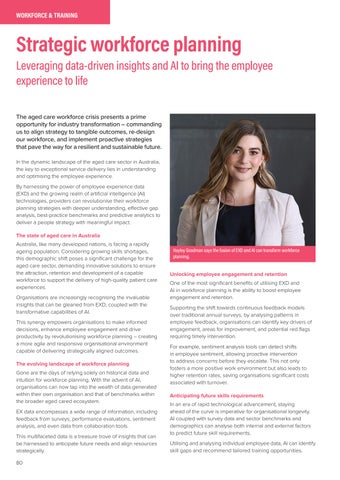WORKFORCE & TRAINING
Strategic workforce planning Leveraging data-driven insights and AI to bring the employee experience to life The aged care workforce crisis presents a prime opportunity for industry transformation – commanding us to align strategy to tangible outcomes, re-design our workforce, and implement proactive strategies that pave the way for a resilient and sustainable future. In the dynamic landscape of the aged care sector in Australia, the key to exceptional service delivery lies in understanding and optimising the employee experience. By harnessing the power of employee experience data (EXD) and the growing realm of artificial intelligence (AI) technologies, providers can revolutionise their workforce planning strategies with deeper understanding, effective gap analysis, best-practice benchmarks and predictive analytics to deliver a people strategy with meaningful impact. The state of aged care in Australia Australia, like many developed nations, is facing a rapidly ageing population. Considering growing skills shortages, this demographic shift poses a significant challenge for the aged care sector, demanding innovative solutions to ensure the attraction, retention and development of a capable workforce to support the delivery of high-quality patient care experiences. Organisations are increasingly recognising the invaluable insights that can be gleaned from EXD, coupled with the transformative capabilities of AI. This synergy empowers organisations to make informed decisions, enhance employee engagement and drive productivity by revolutionising workforce planning – creating a more agile and responsive organisational environment capable of delivering strategically aligned outcomes. The evolving landscape of workforce planning Gone are the days of relying solely on historical data and intuition for workforce planning. With the advent of AI, organisations can now tap into the wealth of data generated within their own organisation and that of benchmarks within the broader aged cared ecosystem. EX data encompasses a wide range of information, including feedback from surveys, performance evaluations, sentiment analysis, and even data from collaboration tools. This multifaceted data is a treasure trove of insights that can be harnessed to anticipate future needs and align resources strategically. 80
Hayley Goodman says the fusion of EXD and AI can transform workforce planning.
Unlocking employee engagement and retention One of the most significant benefits of utilising EXD and AI in workforce planning is the ability to boost employee engagement and retention. Supporting the shift towards continuous feedback models over traditional annual surveys, by analysing patterns in employee feedback, organisations can identify key drivers of engagement, areas for improvement, and potential red flags requiring timely intervention. For example, sentiment analysis tools can detect shifts in employee sentiment, allowing proactive intervention to address concerns before they escalate. This not only fosters a more positive work environment but also leads to higher retention rates, saving organisations significant costs associated with turnover. Anticipating future skills requirements In an era of rapid technological advancement, staying ahead of the curve is imperative for organisational longevity. AI coupled with survey data and sector benchmarks and demographics can analyse both internal and external factors to predict future skill requirements. Utilising and analysing individual employee data, AI can identify skill gaps and recommend tailored training opportunities.
